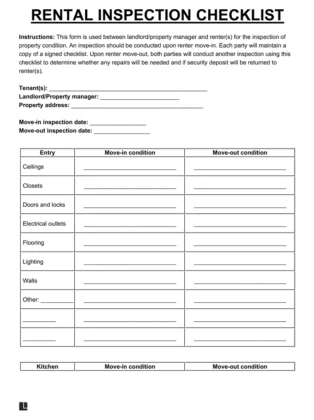
Use our rental inspection checklist to keep an accurate record of your property’s condition.

Updated June 28, 2024
Written by Ioana Gagiuc | Reviewed by Susan Chai, Esq.
A rental inspection checklist is an essential tool for landlords, property managers, and tenants, designed to systematically evaluate the condition of a rental property at various stages of tenancy: during move-in, periodically throughout the tenancy, and at move-out.
This ensures that all aspects of the property are carefully inspected, offering an opportunity to report any issues in each room of your rental. It helps identify maintenance issues, ensures compliance with lease terms, and protects the property’s value.
General information:
Exterior Inspection:
Interior Inspection:
Kitchen Inspection:
Bathroom Inspection:
Miscellaneous:
Here’s a step-by-step guide on how to conduct a thorough rental inspection:
While tenants should be prepared to complete a rental inspection checklist upon signing the lease agreement and entering their new rental, it’s important to note that the process can vary depending on your state’s laws. In some instances, the landlord is required to provide a record of the property’s condition, including any existing damage or both parties complete jointly.
As the landlord or property manager, your responsibilities include:
In addition to logging noticeable damages and defects, it is always advisable to photograph each issue. These photographs provide visual evidence that can be referenced later if disputes arise.
Once a tenant vacates your rental, reference your original copy of the rental checklist and determine if the tenant caused excessive damage during their tenancy.
Move-Out Condition Documentation
It is crucial for both landlords and tenants to document the move-out condition as well. This documentation helps ensure that tenants can receive their security deposits back. Here’s the process if damages occur:
Security Deposit Process
Legal Requirements
Some states require the landlord to provide the tenant with a move-in form or checklist. Even if it is not legally required in your state, it is still prudent to use one to avoid potential disputes and ensure clarity. Having a friend present during the inspection can be helpful. Their observations can serve as additional documentation in case of future disagreements.
Below is a table summarizing the move-in/move-out checklist requirements by state:
| State | Name of Form | Conditions | Statute |
|---|---|---|---|
| Arizona | Move-In / Move-Out Condition Checklist | None | § 33-1321(C) |
| Arkansas | Move-In Inspection Form | None | § 18-17-502 |
| Georgia | Move-In / Move-Out Condition Report | Only if a security deposit is collected | § 44-7-33 |
| Hawaii | Property Condition Form | None | § 521-42(a) |
| Kansas | Inventory and Condition of the Premises | None | § 58-2548 |
| Kentucky | Move-In Inspection Form | Only if a security deposit is collected | § 383.580(2) |
| Maryland | Move-In/Move-out Inspection Form | None | § 8-203.1(a) |
| Massachusetts | Apartment Condition Statement | Only if a security deposit is collected | Chapter 186, Section 15B(2)(c) |
| Michigan | Inventory Checklist Form | Only if a security deposit is collected | § 554.608 |
| Montana | Statement of Condition of Premises | Only if a security deposit is collected | § 70-25-206 |
| Nevada | Inventory and Condition Statement | None | NRS 118A.200(3)(k) |
| New Hampshire | Move-In Checklist | Only if a security deposit is collected | RSA 540-A:6(I)(c) |
| North Dakota | Property Condition Statement | None | § 47-16-07.2 |
| Oregon (City of Portland) | Move-In Checklist | None | § 30.01.087(D)(1) |
| Utah | Move-In Checklist | None | § 57-22-4(6) |
| Virginia | Move-In Move-Out Inspection Report | None | § 55.1-1214 |
| Washington | Move-In Checklist | Only if a security deposit is collected | § 59.18.260 |
| Wisconsin | Rental Condition Checklist | Only if a security deposit is collected | § 134.06 |
| Show More Show Less | |||
Ensuring that a rental property remains in excellent condition is a top priority for any landlord. Here’s where the rental inspection becomes a valuable tool. It helps you achieve the following key objectives:
For tenants preparing to move, consider using a moving checklist to ensure all aspects of your relocation are covered. This can help you avoid missing critical steps and ensure a smooth transition to your new home.
1. Tenant. Provide the tenant’s full name and the person renting the property from the landlord or property manager. If there is more than one tenant, provide the names of all tenants.
2. Landlord. Enter the full name of the landlord or property manager, the person who owns or manages the property.
3. Property Address. Fill in the street (physical) address of the rental property.

4. Move-In Inspection Date. Write the date you are conducting the move-in inspection.
5. Move-Out Inspection Date. Fill in the date you are conducting the move-out inspection.

6. Entry. Write the move-in or move-out condition of each area of the entry if the rental property has an entry area. You can write other portions of the entry not indicated on the checklist.
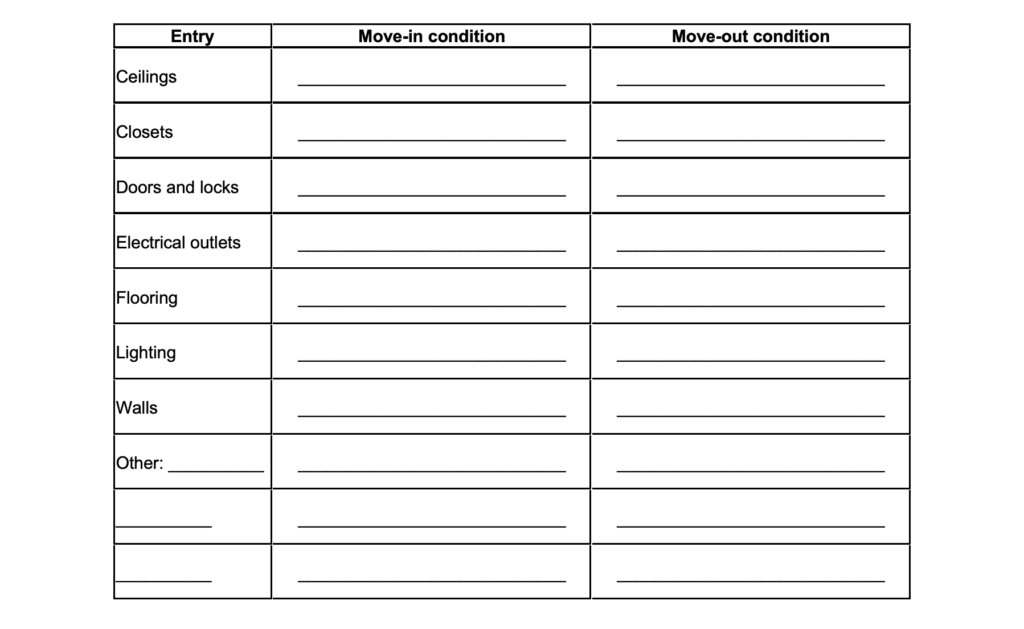
7. Kitchen. State the move-in or move-out condition of each area of the kitchen if the rental property has a kitchen.

8. Living Room. Specify the move-in or move-out condition of the living room if the rental property has a living room.
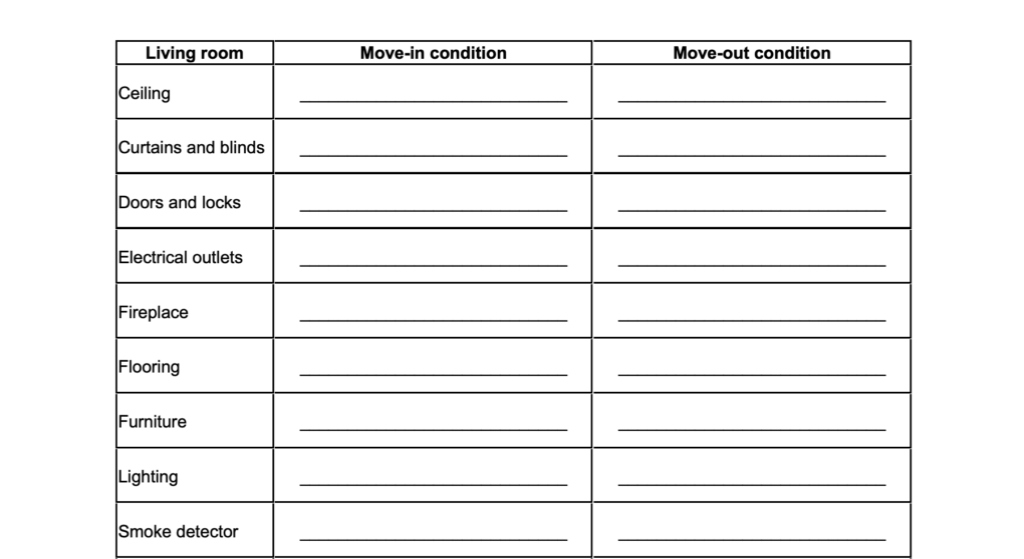
9. Dining Room. Enter the move-in or move-out condition of the dining room if the rental property has a dining room.
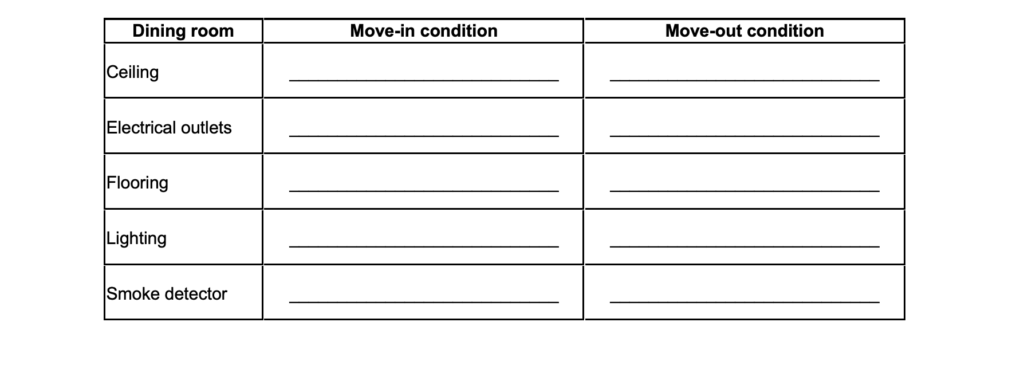
10. Bedroom 1. Fill in the move-in or move-out condition of the bedroom if the rental property has one bedroom.
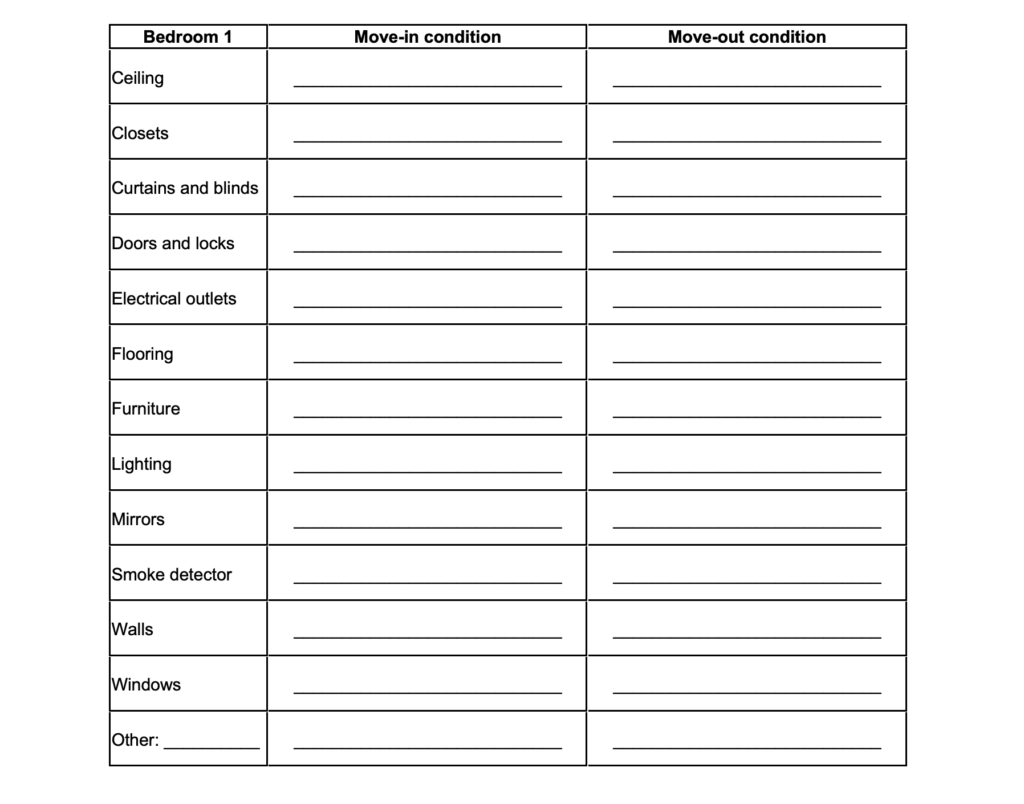
11. Bedroom 2. Write move-in or move-out the condition of a second bedroom if the rental property has a second bedroom. If the rental property has more than two bedrooms, you can add additional sections to the checklist.
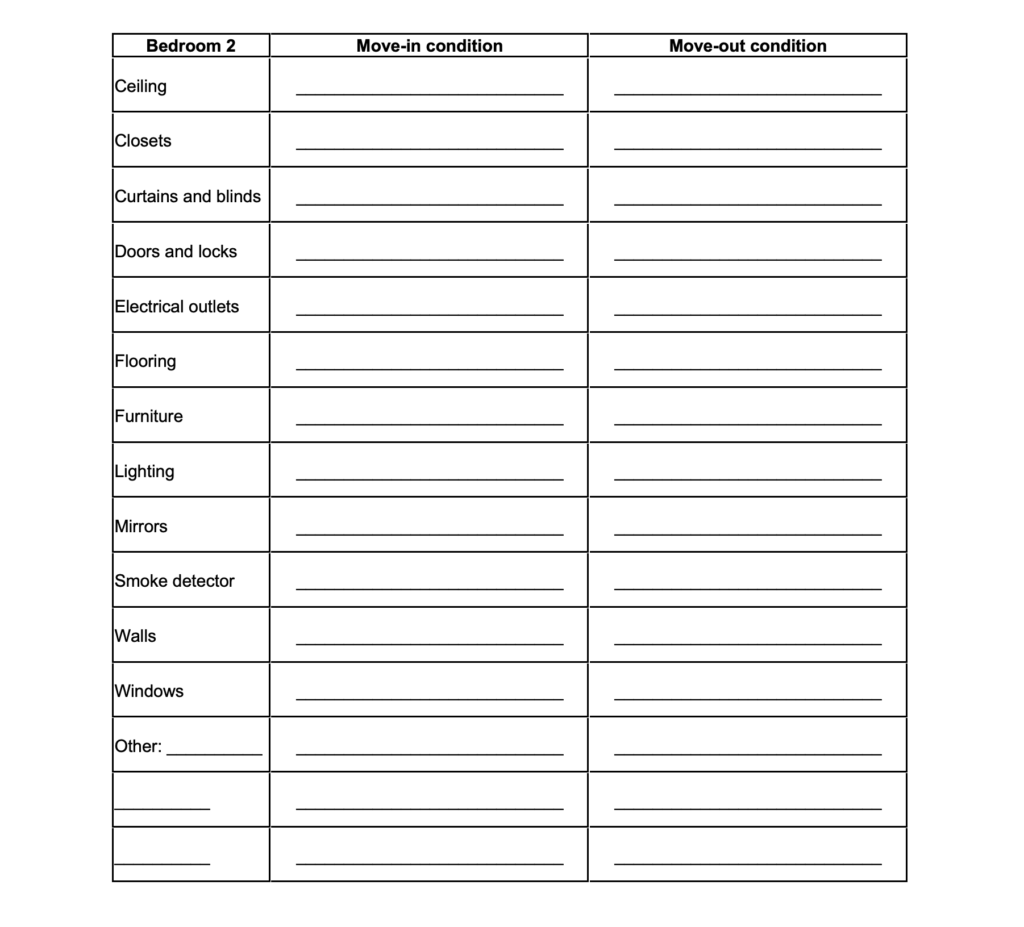
12. Bathroom 1. Document the move-in or move-out condition of the bathroom if the rental property has one bathroom.
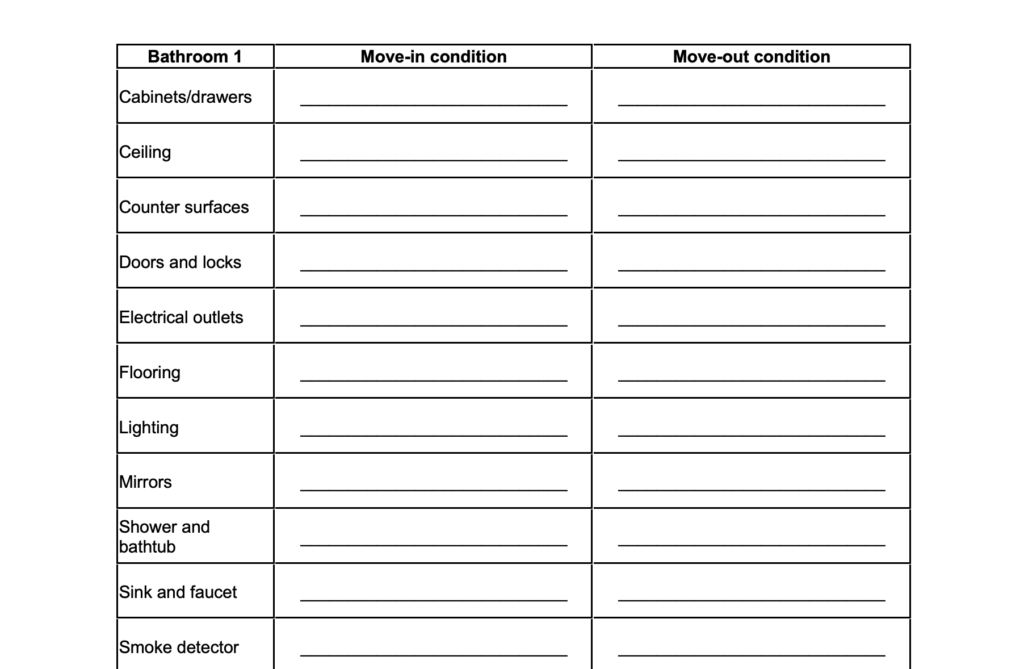
13. Bathroom 2. Enter the move-in or move-out condition of a second bathroom if the rental property has a second bathroom. If the rental property has more than two bathrooms, you can add additional sections to the checklist.
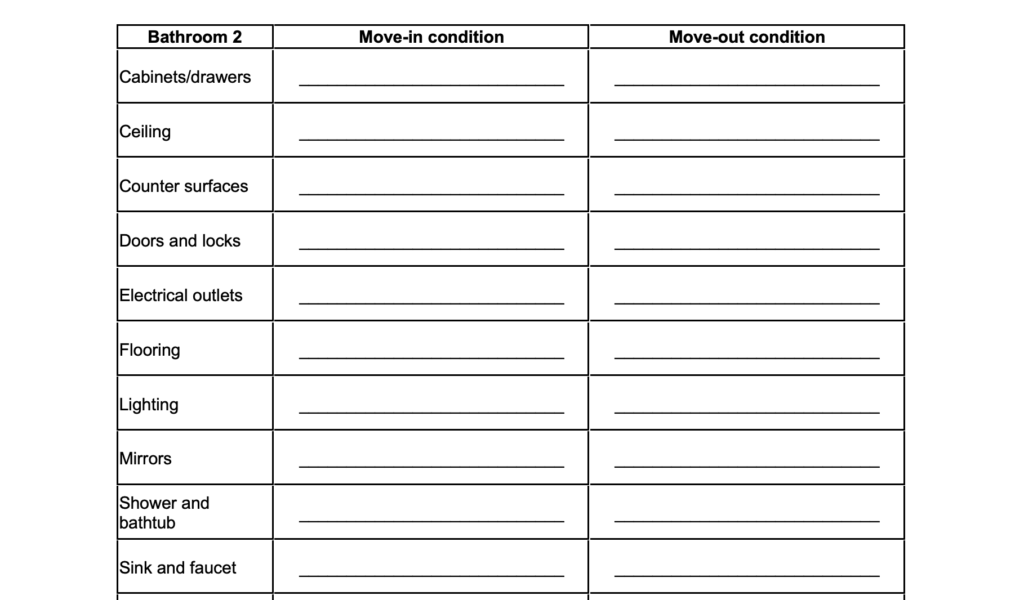
14. Garage. Write the move-in or move-out condition of the garage if the rental property has a garage.
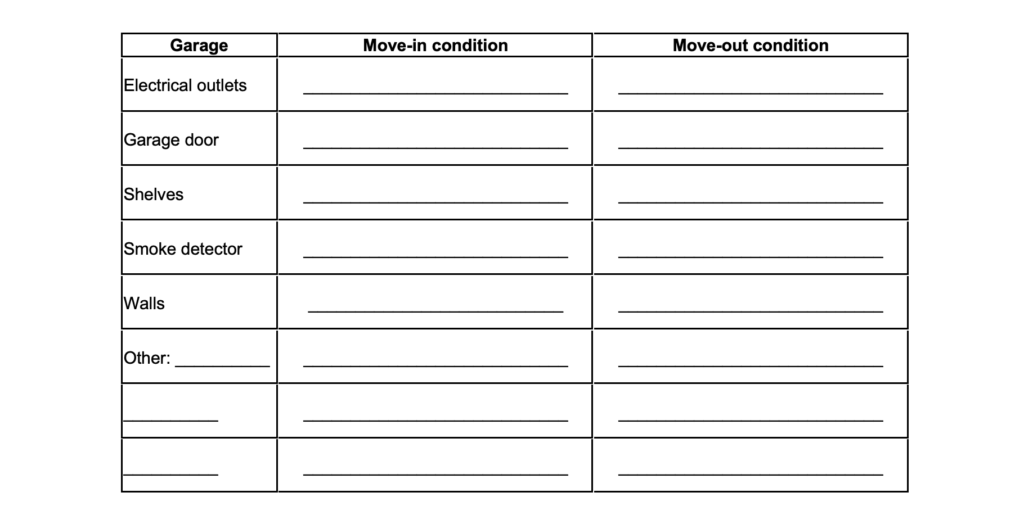
15. Miscellaneous. You can include the move-in or move-out condition of additional spaces in the rental property or items that have not been previously addressed.

16. Other Notes. You can include any additional notes as needed.
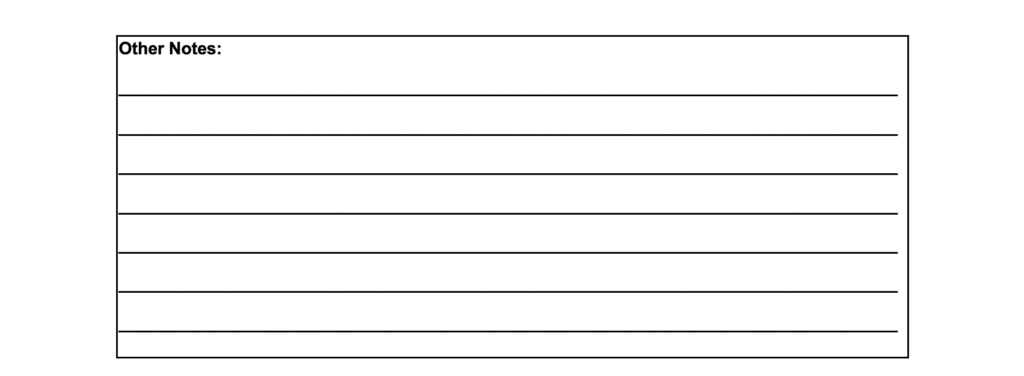
Remember, both the landlord and tenant should review and sign off on the checklist. Taking photos can be a good idea for a clear record. It’s also important to follow the local laws and regulations regarding rental inspections.